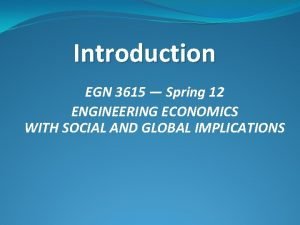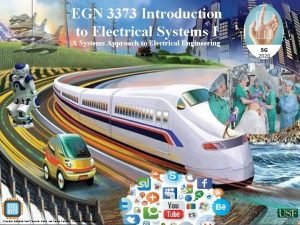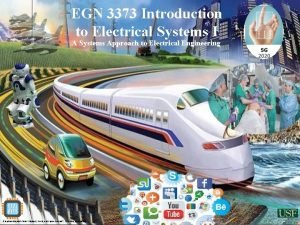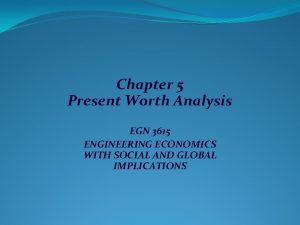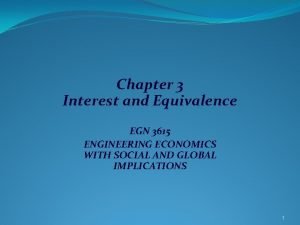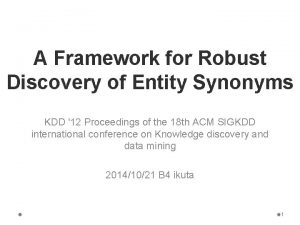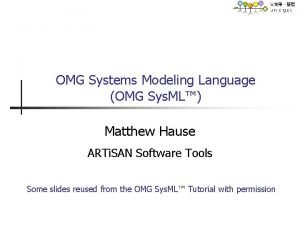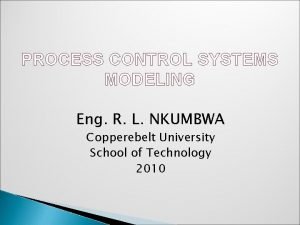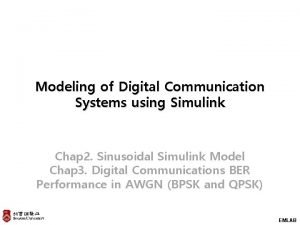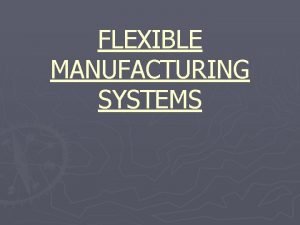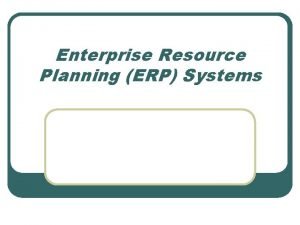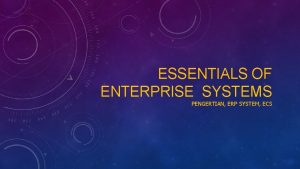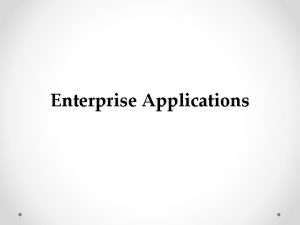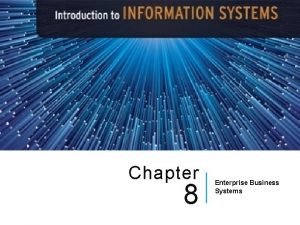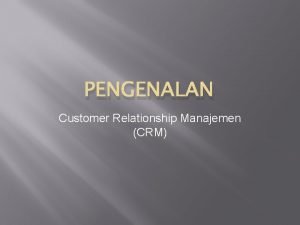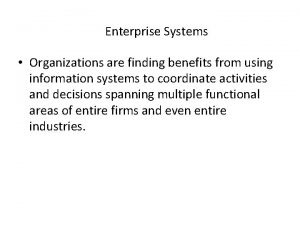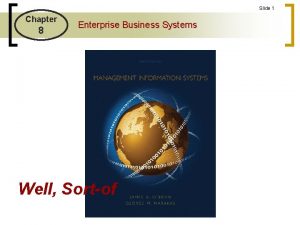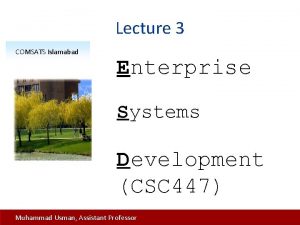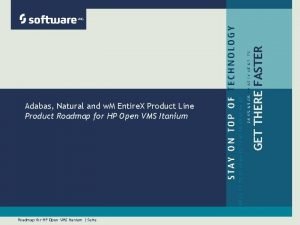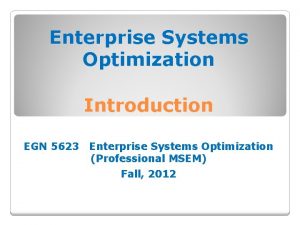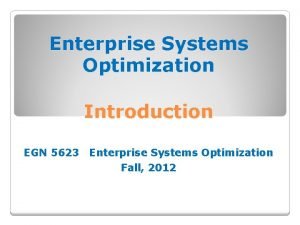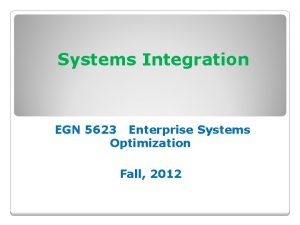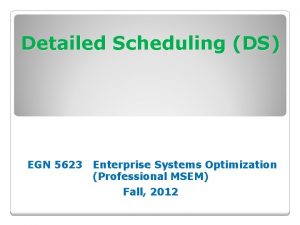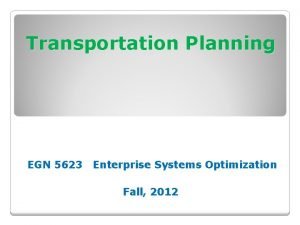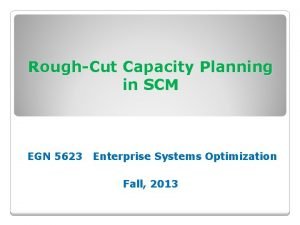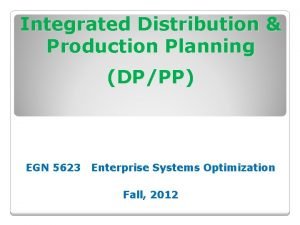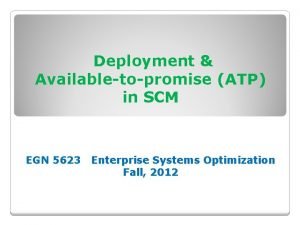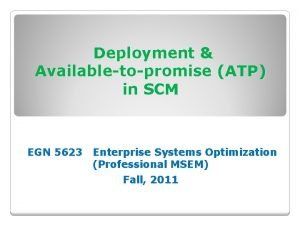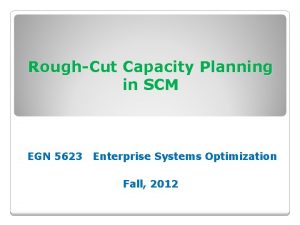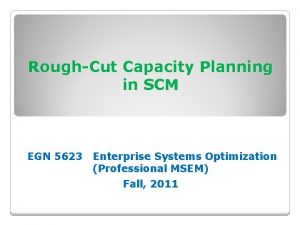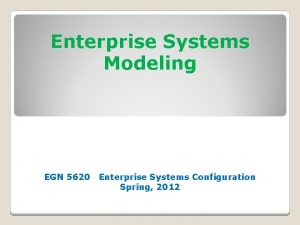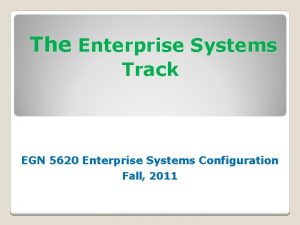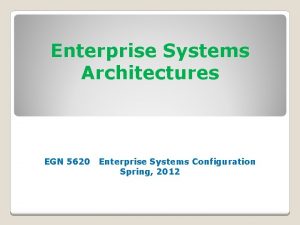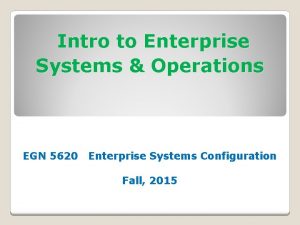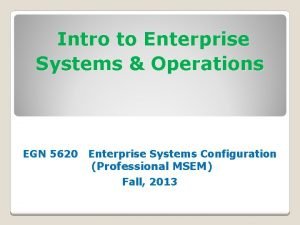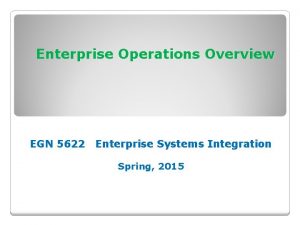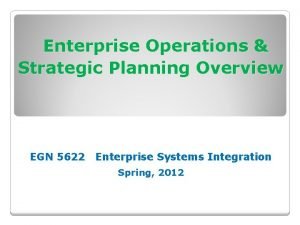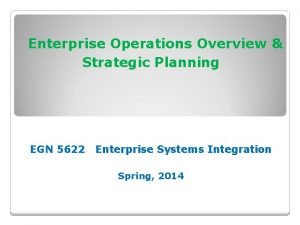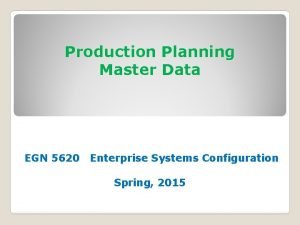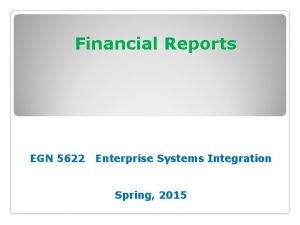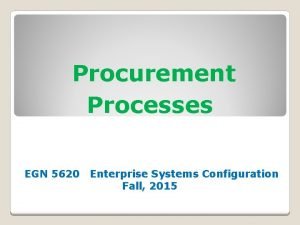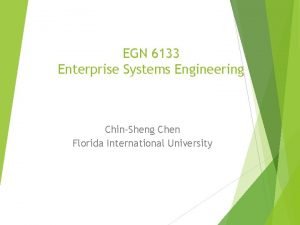Enterprise Systems Modeling EGN 5623 Enterprise Systems Optimization



























- Slides: 27

Enterprise Systems Modeling EGN 5623 Enterprise Systems Optimization Fall, 2012

Information systems modeling tools IDEF ◦ IDEF 0 (activities) ◦ IDEF 1 x (information) ◦ IDEF 2 x (dynamics) OMT ◦ Functional model ◦ Object model ◦ Dynamic model

IDEF Concept (1) IDEF (ICAM Definition) ◦ Developed by the US Air Force Integrated Computer Aided Manufacturing (ICAM) Programs in 1981 ICAM Objective ◦ To develop structured methods for applying computer technology to manufacturing and to better understand how best to improve manufacturing productivity

IDEF Concept (2) IDEF 0 ◦ An activity model of a manufacturing system and environment IDEF 1 ◦ An informational model of the system and environment IDEF 2 ◦ A dynamic model to describe time-varying system behavior

IDEF Concept (3) IDEF Methodology ◦ Modeling process and tools, leading to creation of the three IDEF models IDEF 0 (activities) IDEF 1 x (information) IDEF 2 x (dynamics) Commercial IDEF software tools ◦ Design/IDEF by Meta Software Company ◦ AI 0 WIN by Knowledge Based Systems Inc.

OMT Concepts (1) Object modeling technique (OMT) “Object-oriented” means: ◦ Software organized as a collection of discrete objects that incorporate both data structure and behavior, in contrast to conventional programming in which data structure and behavior are only loosely connected. OMT ◦ ◦ Methodology (in stages): system analysis, system design, Object (implementation) design, and implementation.

OMT concepts (2) - common themes Synergy (i. e. , shifting focus from coding technique to packaging, based on consistent ◦ identity, ◦ classification, ◦ polymorphism, and ◦ inheritance Abstraction, Encapsulation, Combining Sharing data and behavior, (inheritance of data structure & behavior among subclasses) Emphasis on object structure (not procedure structure),

OMT Concepts (3) - Synergy Identity ◦ Data is quantized into discrete, distinguishable entities called objects Classification ◦ Objects with the same data structure (attributes) and behavior (operations) are grouped into a class An operation is an action or transformation that an object performs or is subject to. polymorphism ◦ The same operation may behave differently on different classes. A specific implementation of an operation by a certain class is called a method. Each operation may have multiple methods implementing it. inheritance ◦ The sharing of attributes and operations among a hierarchy of object classes

OMT Models (4) 3 OMT models used to describe a system: ◦ Object model describing the objects in the system and their relationships; ◦ Dynamic model describing the interactions among objects in the system; and ◦ Functional model describing the data transformation of the system. Their relationship ◦ The object model describes what changes (or transforms) before when (dynamic model) or how (functional model) it changes.

OMT Functional Model (5) It describes the data value transformations within a system. The functional model contains data flow diagrams. ◦ A data flow diagram is a graph whose nodes are processes (activities) and whose arcs are data flows.

OMT Object Model (6) It describes the static structure of the objects in a system and their relationships. The object model contains object diagrams. ◦ An object diagram is a graph whose nodes are object classes and whose arcs are relationships among classes.

OMT Dynamic Model (7) It describes the aspects of a system that change over time and is used to specify and implement the control aspects of a system. The dynamic model contains state diagrams. ◦ A state diagram is a graph whose nodes are states and whose arcs are transitions between states caused by events.

Relationship between the two techniques & among the three models IDEF 0/functional model ◦ The input to an activity is usually through a user interface for data entry ◦ The output from an activity is usually a user interface for a report, though the output may be a write/update to a database. IDEF 0’s ◦ ICOM Material is an input object. Product/process data are output objects. Rules/regulations and SOPs are constraints. Technical precedence is a constraint Resources/tools and methods are a mechanism. IDEF 1/object model ◦ The collection of the ICOM of an IDEF activity model constitutes an inclusive foundation for the object model. IDEF 2/dynamics model ◦ Each object requires a state diagram to define/govern its life-cycle behavior. ◦ A triggering event is associated with each transition from one state to another. One state may transform to multiple states, depending on the triggering event.

Relationship between the two methods and among the three models IDEF 0/functional model ◦ The input to an activity is usually a user interface for data entry ◦ The output to an activity is usually a user interface for a report, though the output may be a write/update to a database. ◦ ICOM Material is an input object. Product/process data are output objects. Rules/regulations and SOPs are constraints. Resources/tools and methods are mechanisms. IDEF 1/object model ◦ The collection of the ICOM of an IDEF activity model constitutes an inclusive foundation for the object model. IDEF 2/dynamics model ◦ Each object requires a state diagram to define/govern its life-cycle behavior. ◦ A triggering event is associated with each transition from one state to another. One state may transform to multiple states, depending on the triggering event.













 Egn 3615
Egn 3615 Egn 3373
Egn 3373 How to convert ac to dc
How to convert ac to dc Capitalized cost engineering economy
Capitalized cost engineering economy Egn 3615
Egn 3615 Egn synonym
Egn synonym Modeling role modeling theory
Modeling role modeling theory Relational modeling vs dimensional modeling
Relational modeling vs dimensional modeling Omg systems modeling language
Omg systems modeling language Modeling mechanical systems examples
Modeling mechanical systems examples Control systems modeling
Control systems modeling Modeling of digital communication systems using simulink
Modeling of digital communication systems using simulink Modeling of digital communication systems using simulink
Modeling of digital communication systems using simulink Manufacturing systems modeling and analysis
Manufacturing systems modeling and analysis Putting the enterprise into the enterprise system
Putting the enterprise into the enterprise system Enterprise
Enterprise Application of enterprise resource planning
Application of enterprise resource planning Topic 2 free enterprise and other economic systems
Topic 2 free enterprise and other economic systems Enterprise collaboration system adalah
Enterprise collaboration system adalah Enterprise systems include analytical tools.
Enterprise systems include analytical tools. Crm modules
Crm modules Enterprise business systems
Enterprise business systems Benefits of enterprise systems
Benefits of enterprise systems Enterprise ticketing systems
Enterprise ticketing systems Enterprise business systems
Enterprise business systems Enterprise systems development
Enterprise systems development What is an enterprise payment system?
What is an enterprise payment system? Enterprise transaction systems
Enterprise transaction systems
